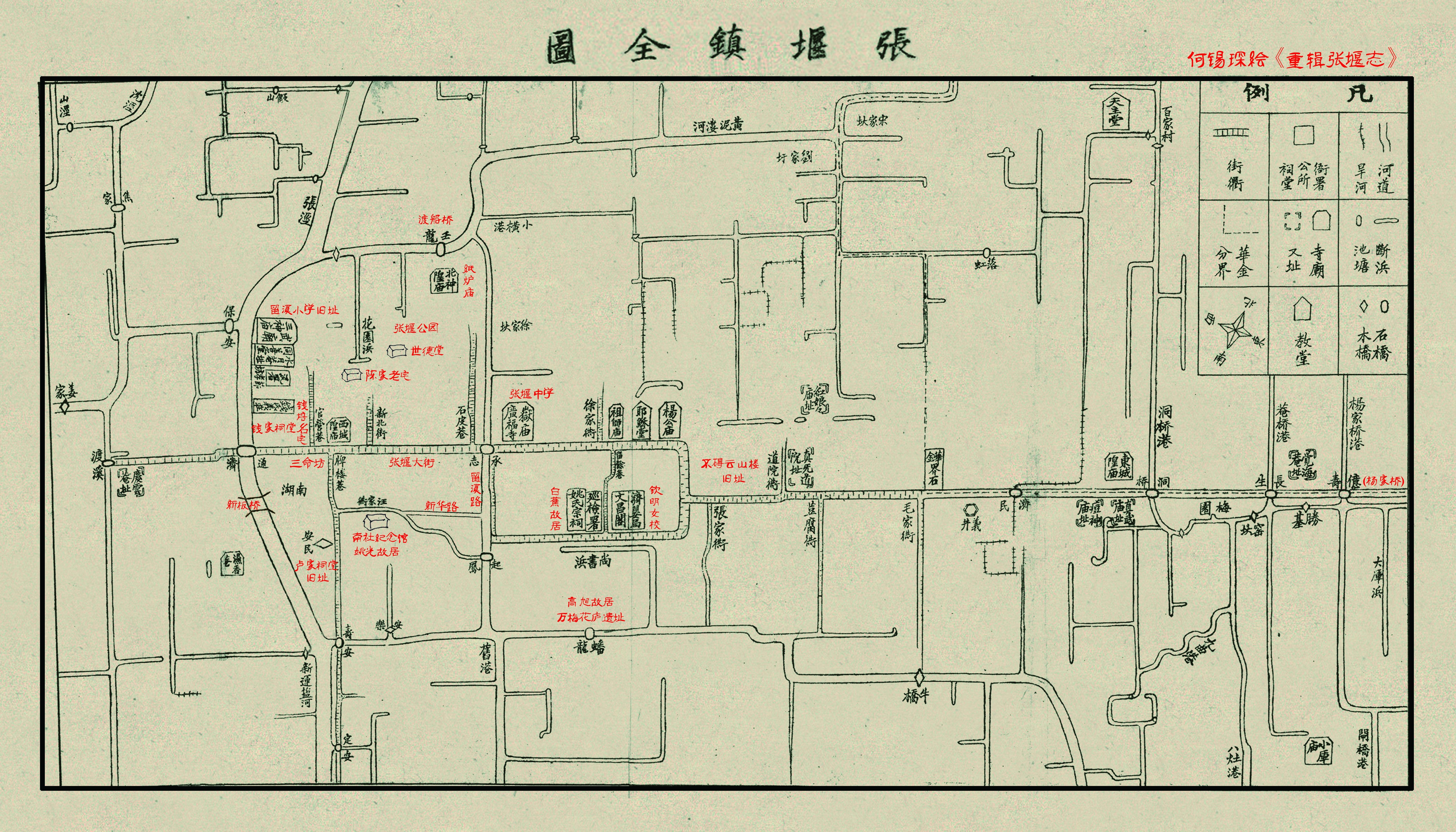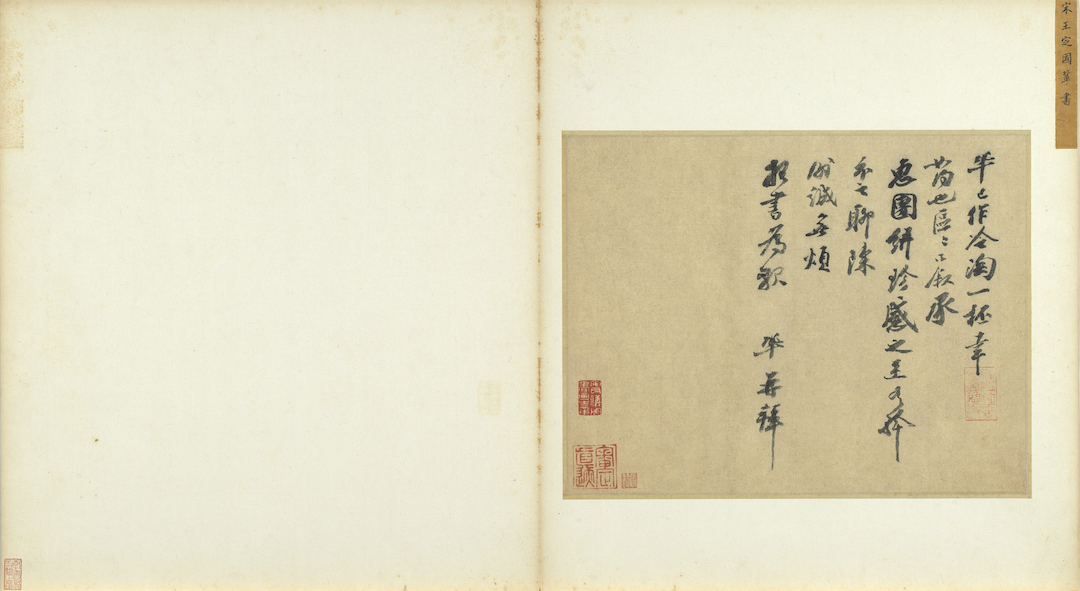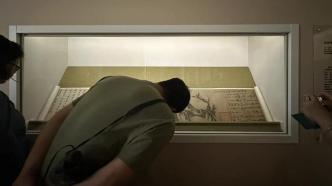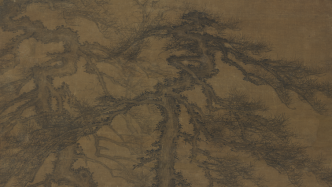
2022 is the 750th anniversary of the birth of Cao Zhibai, a Shanghai painter in the Yuan Dynasty. The Paper learned that on December 15, the "Yundu Qingyue-Academic Theme Exchange Activity in Commemoration of the 750th Anniversary of Yuan Dynasty Painter Cao Zhibai's Birth" sponsored by Shanghai Qingpu District Culture and Tourism Bureau was launched at the Qingpu District Museum. This is another important cultural event to commemorate Cao Zhibai after Cao Zhibai's exhibition and painting collection. On the day of the event, the participating experts focused on the themes of Cao Zhibai or Qingpu, Shanghai cultural history, and Chinese art history. Group studies were discussed.
Wang Hui, research librarian of Qingpu District Museum, gave a speech titled "A Brief Analysis of the Cultural Pattern of Songjiang Prefecture in the Yuan Dynasty". He believes that during the Yuan Dynasty, due to the financial support of economic development, the relatively stable regional environment, open and inclusive ideas, and the cultural attitude of modest learning in the Songjiang Prefecture area, Cao Zhibai, Ren Renfa, Zhang Zhong, Lu Juren and other groups of indigenous literati and scholars Sexual growth attracted a group of cultural elites such as Shao Guizi, Huang Gongwang, Yang Weizhen, Tao Zongyi, etc. to gather together, and Zhao Mengfu, Zhang Zhihan, Wang Yong, etc. traveled and fueled the flames for officials. The above three cultural forces representing the mainstream of the times are here Convergence and integration, creation and production, and at the same time, cultural collection activities based on the platform of wealthy households and literati come one after another, achieving fruitful literary and artistic achievements, and enhancing and establishing the cultural influence and status of Songjiang Prefecture in the country, which is compatible with and synchronized with economic development. , Changing the relatively backward situation of the culture of the previous generation, it can be described as "accumulating and thriving".
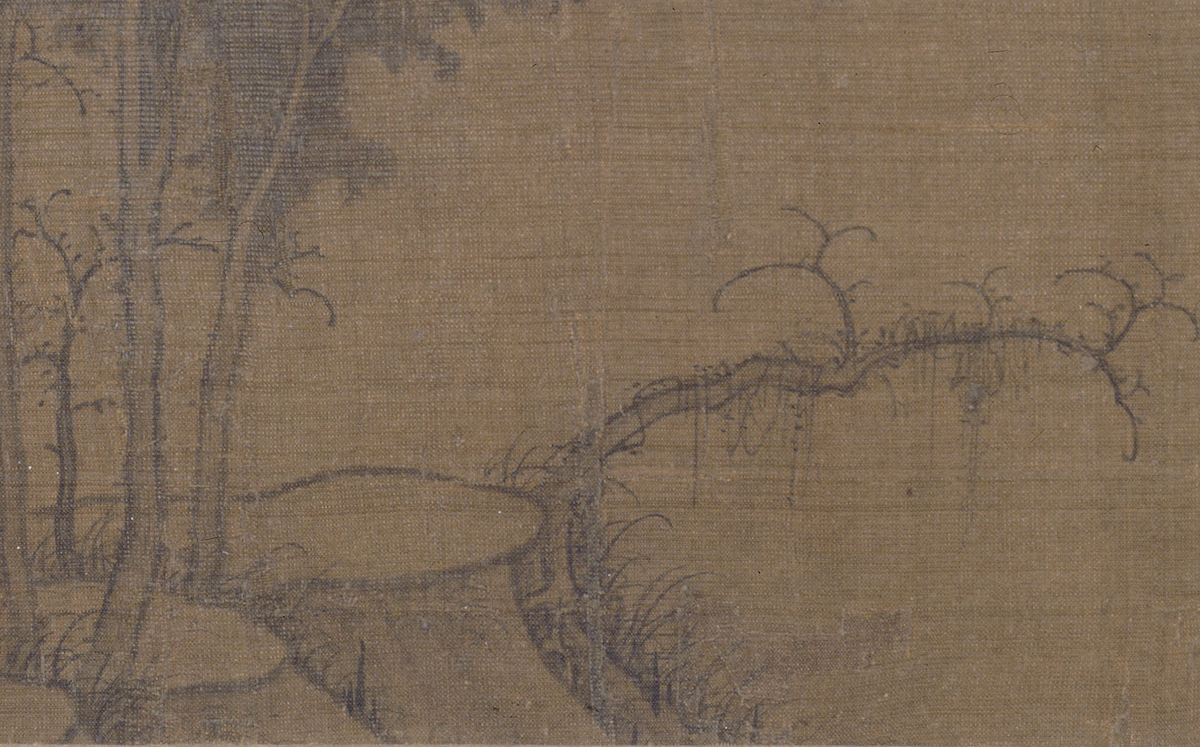
Cao Zhibai's "Cool Night Green Picture" (partial) photo courtesy of Shanghai Museum
"From a historical perspective, the Yuan Dynasty was the first cultural peak period in Songjiang Prefecture, presenting a brand-new cultural pattern led by famous artists, distributed at multiple points, open and inclusive, relatively independent and interacting with the surrounding areas, and became a cultural pattern with Wuzhong and Zhejiang provinces. An emerging cultural highland that keeps pace with the west. This pattern has distinct imprints of the times and prominent regional characteristics, laying a solid cultural foundation for the development and prosperity of Shanghai's culture during the Ming and Qing Dynasties." Wang Hui said.
Qingpu Museum librarian Wang Tiezhong believes that the spirit of seclusion, as the personal pursuit and value orientation of ancient literati, is also reflected in the implication of Cao Zhibai's landscape paintings in the Yuan Dynasty. The unique Cao's landscape style depicts the elegant and poetic flavor of the Jiangnan landscape with vigorous and gentle brush and ink. Cao Zhibai's hermit thought is to be successful in doing nothing. With a positive attitude towards life that is secluded but caring about the world, he attaches great importance to family education, presides over Cao Yuan Gathering, and expands the traditional literati Youyou Gathering together with his contemporaries Gu Ying, Ni Zan and others. Hidden in the cultural inheritance of calligraphy and painting. It attaches great importance to "ink painting" and the idea of abandoning officialdom and seclusion. In essence, it is also a revival and remembrance of the orthodox Chinese culture of the Song Dynasty in the past, and it represents the integrity, responsibility and forbearance of the traditional Chinese literati group. The indifference of life, which is rich in human fireworks and values the quality of life, has become the unique meaning and aesthetic cognition of Cao Zhibai's landscape paintings under the hermit spirit. And this kind of cultural characteristics of indifference, clear aspirations and elegance are also the unique connotation of Jiangnan culture.

Yuan Cao Zhibai (pattern) Landscape Taipei National Palace Museum Collection This piece is selected from "Landscape Collection of Yuan and Ming Dynasty Paintings"
Sun Jingyu, a librarian at the Shanghai Cultural Relics Protection Research Center, made an authenticity appraisal of this calligraphy and painting through research on the albums of Cao Zhibai's landscapes collected by the National Palace Museum in Taipei. According to reports, this landscape album is one of the "Yuan and Ming Dynasty People's Painting Landscape Album". "Shiqu Baoji Sequel". "I checked the records of the National Palace Museum in Taipei and Wang Jiqian's reading notes, and I think it is authentic. Wang Jiqian rated it as 'excellent' and circled it three times. I think in the catalog of "Yundu Qingyue" This painting is a fake, mainly based on four points: 1. The contents of the inscriptions and postscripts are incompatible; The technical level is not high, the composition is messy, and the sense of hierarchy is poor." Sun Jingyu said.
Sun Jingyu was also deeply disturbed due to the huge difference from the previous cognition. After in-depth investigation of the calligraphy of the inscription and postscript, the seal used for the inscription and postscript, and the painting style, Sun Jingyu still insisted on the original point of view, and further deduced that this was a copy in the early and middle Ming Dynasty. The research path he proposed has five points: 1. The calligraphy of Wang Mian and Zheng Yuanyou's inscriptions and postscripts is compared with more reliable authentic works; People in the Yuan Dynasty painted trees with hooks and rubbings, and people in the Ming Dynasty used hooks all over; 4. The painting method of mountains is rubbing and dyeing, which is the characteristic of Ming Dynasty people. The characteristic of Yuan Dynasty is rubbing and rubbing; Song, Jin, Yuan and Ming have a complete line of inheritance, especially the inheritance of professional painters, which is clearly reflected in the tomb murals, and literati paintings are more or less affected.
Sun Jingyu believes that careful study of this album will help to identify the forgery of the Ming Dynasty, and it will also help to understand the lineage of painting history. Today's mainstream narrative of Yuan, Ming and Qing landscape paintings is literati painting, but the Li-Guo School has always been an undercurrent, running through the Song, Jin, Yuan and Ming Dynasties.
Professor Zhang Changhong, director of the Department of History and Theory of Shanghai Academy of Fine Arts, Shanghai University, made a discussion on the topic of "Cao Zhibai and the Painting Tradition of Ink Pine and Stone Paintings". According to him, the theme of ink painting with pine and stone was mainly popular from the middle Tang Dynasty to the Five Dynasties period. Representative painters include Zhang Yu and Jing Hao. This theme continued until the early Northern Song Dynasty. Mi Fu's "History of Painting" records the works of Li Cheng's four-axis pine and stone paintings that he collected: Li Cheng only saw two works of landscapes, one with pine and stones and the other with landscapes. The four-axis pine and rocks all came from Sheng Wensu's house, which is now in Yuzhai; the landscape is in the place of Master Baoyue in Suzhou. It is beautiful and moist, pine and vigorous, and its branches and leaves are full of shade. It is a small tree in Jingchu, without redundant brushwork, and does not look like a dragon, snake, ghost or god.
Zhao Mengfu, a painter in the Yuan Dynasty, strongly advocated "returning to the past" and practiced it personally, including the restoration of the "Pine and Stone Picture"-he specially created a "Pairing Pine with Pine Trees" (now in the Metropolitan Museum of Art, USA). What Zhao Mengfu wants to promote is actually the tradition of "Song Shi Tu" by Zhang Yu and others in the Tang Dynasty. His improvement is to add calligraphy brushes. There are clear records of Zhao Mengfu's interest in Zhang Yansongshi. Tang Hou's "Ancient and Modern Paintings" records: "Zhang Yan's pine and stone are clean and lovely. I have tasted four books in my life, and they are all excellent. Later I got "Shan Tang Qin Hui Tu". Zhao Ziang saw it, but he couldn't get it. This volume is the least in the world, and this volume is deep and flat, like walking in a mountainous vagina, painted by Cheng Bao." Of course, as far as the effect of brush and ink is concerned, Wu Zhen in "Four Masters of the Yuan Dynasty" is relatively more faithfully rendered in the way of silk and ink rendering. Tracing the tradition of Songshitu. It shows that this theme still has a certain audience in the Yuan Dynasty painting circle.

Yuan Cao Zhibai's "Twin Pines" Collection of the National Palace Museum, Taipei
Zhang Changhong believes that there are at least two sources for Cao Zhibai's inheritance of the subject matter of the ink and wash pine and stone paintings. His study of Li Cheng's landscape style is recognized by everyone, and this is a source. The second source is Zhao Mengfu, the leader of the Yuan Dynasty painting circle. "Cao Zhibai's surviving works such as "Shuangpine Picture", "Pine Forest Pingyuan" and "Song Song Youxiu Picture" are all on the extension line of ink pine and stone paintings since the mid-Tang Dynasty. From this perspective, discuss the restoration of Yuan Dynasty painters and their understanding of the Han nationality. The preservation of cultural traditions is of special significance," he said.
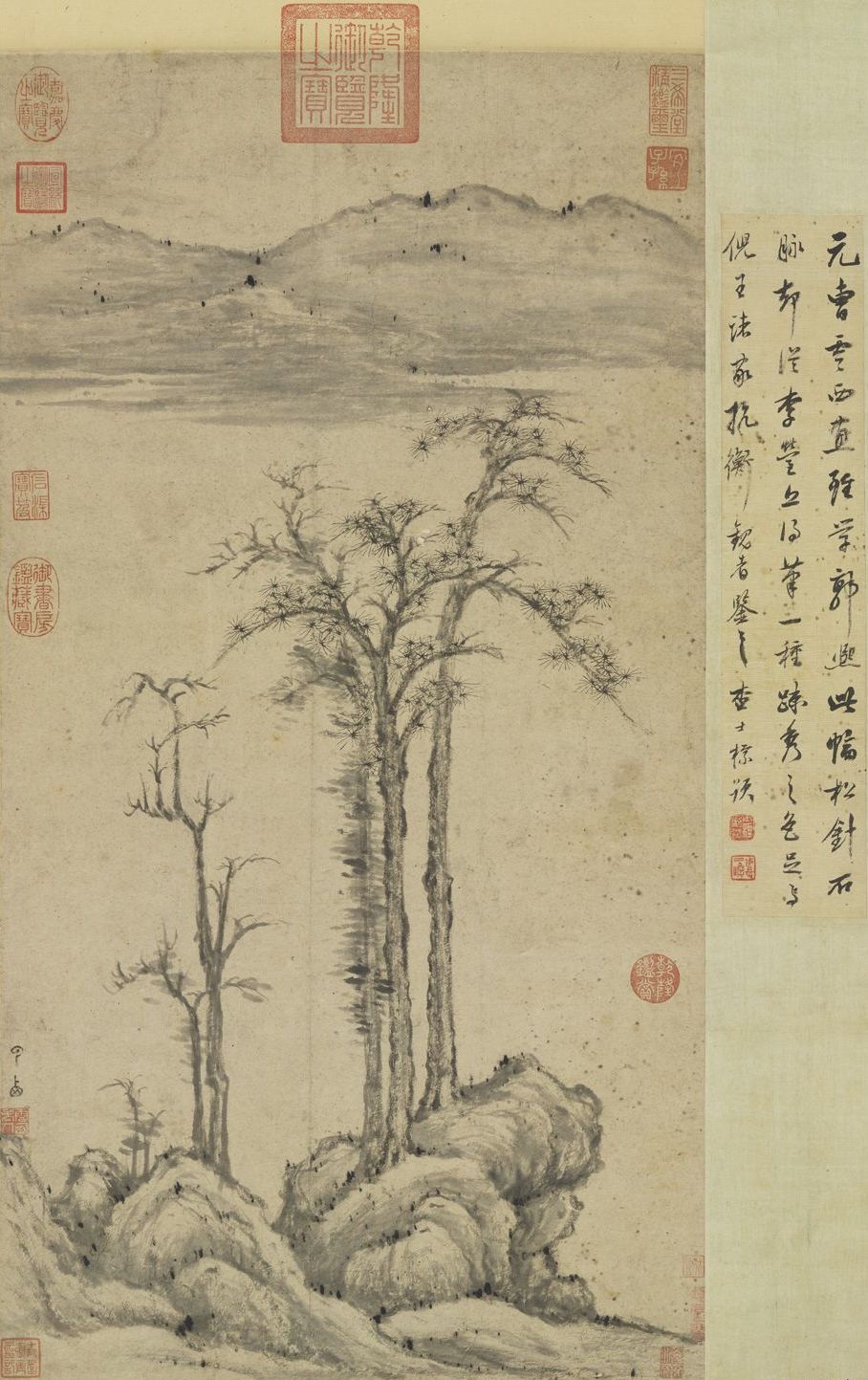
Yuan Cao Zhibai (type) "Pine Forest and Ping Yuan" axis Collection of the National Palace Museum, Taipei
Shi Qi, a professor at the School of Fine Arts of East China Normal University, believes that the title of "Double Trees" has long been regarded as an image proof of the Yuan Dynasty's restoration of the painting history of the Tang Dynasty and the Northern Song Dynasty, but in fact it hides the "Double Trees" as a metaphor for friends and pillars. Two meanings. The presenting of friends and making friends in Cao Zhibai's "Twin Pines" reflects the mentality of the literati living in seclusion in the south of the Yangtze River in the Yuan Dynasty. Although the image of the "double tree" symbol with such meaning mainly inherits the tradition of Li and Guo in the painting history of the Northern Song Dynasty, the inner meaning only exists in the paintings of friends in the south of the Yangtze River in the Yuan Dynasty.
Ling Lizhong, director of the Painting and Calligraphy Research Department of the Shanghai Museum and a research librarian, gave a speech titled "Cao Zhibai's role in becoming the center of Jiangnan literati painting activities in Shanghai at the end of the Yuan Dynasty". He believes that Cao Zhibai's artistic style is a combination of Li Cheng and Guo Xi, and he is one of the important representative painters of the "Li Guo School" in the Yuan Dynasty. He is especially good at snowy and cold forests. He uses "crab claws" and "deer horns" to produce branches, which can give new ideas to the brush lines.
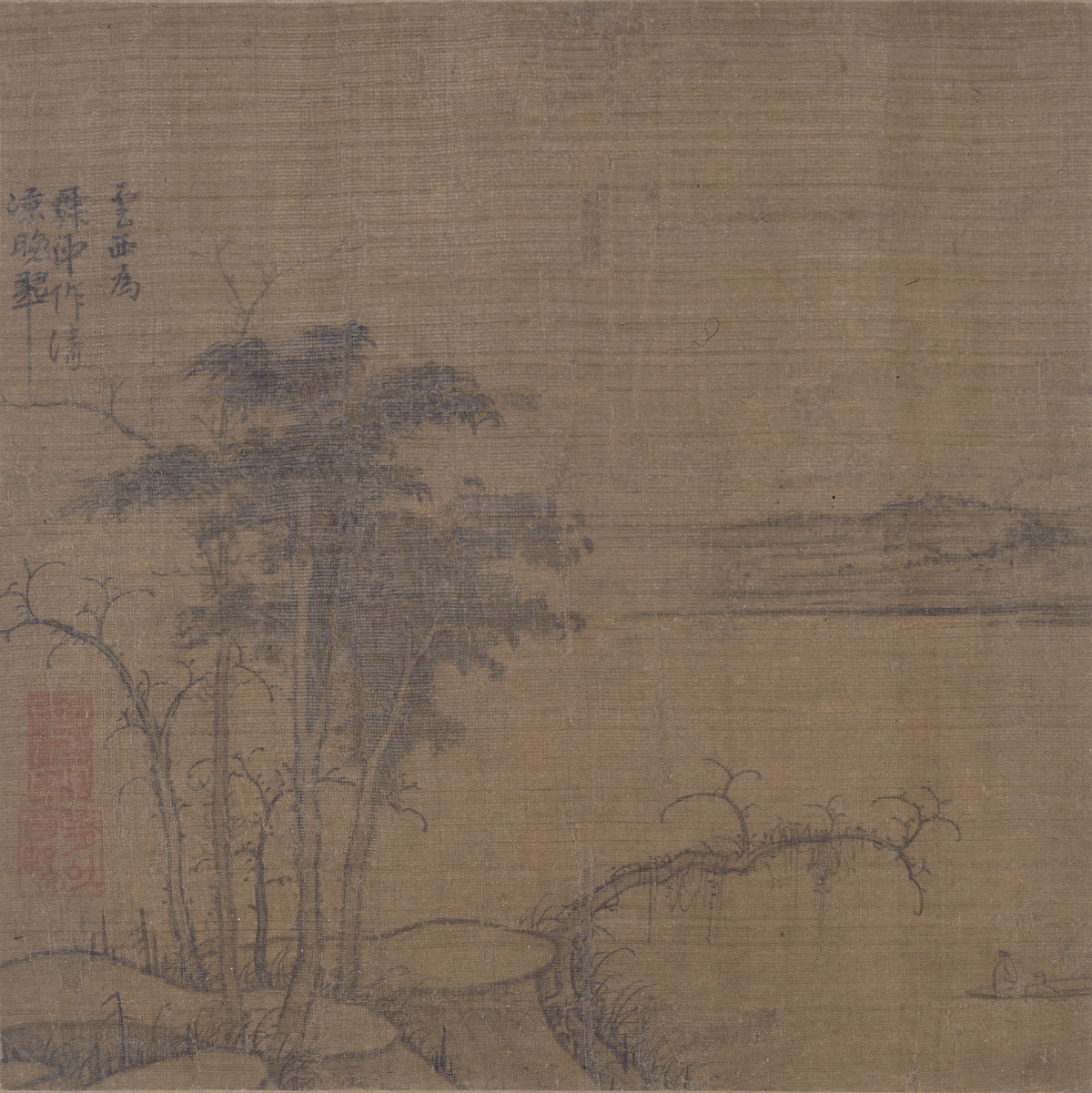
Cao Zhibai, "Cool Evening Greenery Picture", ink and wash on silk, 21.2 cm in length and 21.2 cm in width, photo courtesy of Shanghai Museum
He Liangjun, a connoisseur of Fengxian in the Ming Dynasty, spoke highly of it: "I am good at painting pine trees, and there is no one better than Cao Yunxi when I was in Shengguo. Li Cheng is the master of Pingyuan, and Guo Xi is the master of landscape. Li Cheng is also the master of Guo. Most of the works handed down from generation to generation are in the cold forest. , snow scene as the subject matter, or related to the origin of its painting method, such as "Qingliang Evening Green Picture", one of the 72 national treasures in the 2002 Shanghai Museum "National Treasures of Calligraphy and Painting Exhibition of Jin, Tang, Song and Yuan Dynasties" exhibited at Qingpu Museum, was painted in "Picture of Snowy Peaks" in 1349 (Huang Gongwang's 1350 title "The brushwork is ancient and light, with the rhyme of Mojie, and the servant's touch is not dare to look up to it"). The latter "Picture of Snowy Peaks" is similar in artistic conception to "Picture of Nine Peaks under Snow" created by Huang Gongwang during his residence in Shanghai in the first month of 1349, which may be a testimony to the mutual influence between the two.
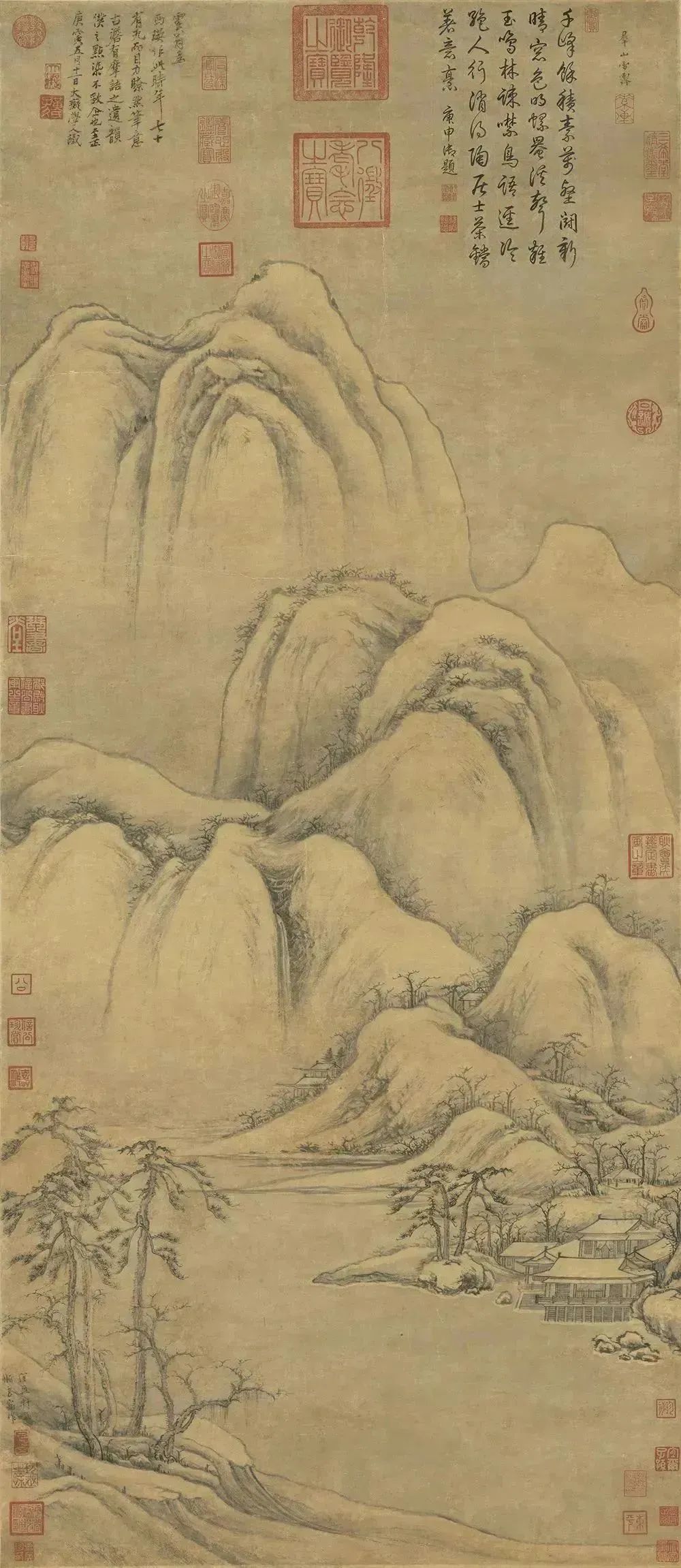
Cao Zhibai's "Snow in the Mountains" axis
It is worth mentioning that in May 1349, Huang Gongwang inscribed Cao Zhibai's "Chongxi Evening Cloud Map", which also said, "The old cloud is similar to the servant year. It has been a long time to write and moisten the ink. It is old and healthy. Today's There are many famous and good painters seeking ingenuity. As for the clear and clear rhyme, this old man is unique. On May 25th of the ninth year of Zhengzheng, the inscription was written by a big idiot. It was eighty and one years old." "Rhyme "Qingyue" is the best summary of Cao Zhibai's artistic style, which can be called Zhiyan. Wang Yuanqi, a painter in the Qing Dynasty, said, "Out of the four famous artists from the Yuan Dynasty, Cao Yunxi is the most popular."
Jiang Fangting, an associate researcher at the Hong Kong Palace Museum, gave an online speech on "A Preliminary Study of Yao Tingmei's "You Leisure Picture"". She introduced that from Emperor Shun of the Yuan Dynasty to the late Zhengzheng period, there were powerful separatist regimes and frequent wars. Against this background, a type of residence map with a combination of poetry, calligraphy and painting, drawn for recluses with status, appeared concentratedly in Wusong and its surrounding areas. In the twentieth year of Zhengzheng (1360), the painter Yao Tingmei made "You Leisurely Picture" (Cleveland Museum of Art collection) for Du Yingfa, Du Min and his son who lived in seclusion in Songjiang Qinglong (now Qingpu, Shanghai). Since the Ming Dynasty, the history of painting has often classified Yao Tingmei, Cao Zhibai, Zhu Derun, Tang Di and other painters into the Li Guo School.
Jiang Zhiming, a professor at East China University of Science and Technology, discussed the friendship between Cao Zhibai and Huang Gongwang. According to the introduction of Huang Gongwang in Zhengde's "Songjiang Mansion Chronicle", "he is the best with Cao Zhibai". According to Li Rihua's "Zi Tao Xuan You Zhu", Huang Gongwang "is friendly to Zhisong and Cao Zhibai".
Huang Gongwang wrote a poem for "Cao Yunxi Picture Scroll": "I met Zheng Yijun for ten years, and suddenly I saw cold clouds from the paper. The empty river is deserted, and the fishing song is full of songs. A sparse forest leads to sunset." And the preface, "Yunxi and Yu have friendship. From the old days, don’t come back for four years, I really miss it.” The preface of the poem, as close as brothers. The last two sentences of the poem use the middle scene of the painting to praise Yunxi's chic and comfortable life in Yuyin.
Jiang Zhiming believed that Huang Gongwang and Cao Zhibai became close friends because firstly, they shared the same pursuit of artistic hobbies; secondly, they shared common experiences, both served in government offices, and later lived a secluded life; thirdly, they were fellow villagers. Huang Gongwang was born in Changshu. His grandfather, Lu Tinglong, lived in Huating for generations. Although he had no choice but to adopt the Huang family in Pingyang because of his father's death, the blood of the Lu family in Huating flowed through him; The inscription and postscript of Cao Shichang's "Intention of Rain, Mountains and Streams" is called "Shichang", which is what the elders call the younger generation.
In addition, information such as Cao Zhibai's son-in-law Lu Yong, the in-law relationship between the Cao family and the Lu family, and Huang Gongwang's younger brother Lu Decheng's son Lu Xingzhi who lived in Songjiang Mansion made the relationship between Huang Gongwang and Cao Zhibai even closer.
Yan Xiaojun, an associate research librarian of the Painting and Calligraphy Research Department of the Shanghai Museum, took the title of "Making Cao Zhibai——Cao Zhibai's Life in Ancient Shanghai and Problems of Poetry and Painting", trying to outline the poetry and painting life of Cao Zhibai and his friends in ancient Shanghai at that time, and through Some examples to analyze the reasons why people love Cao Zhibai and those interesting things.
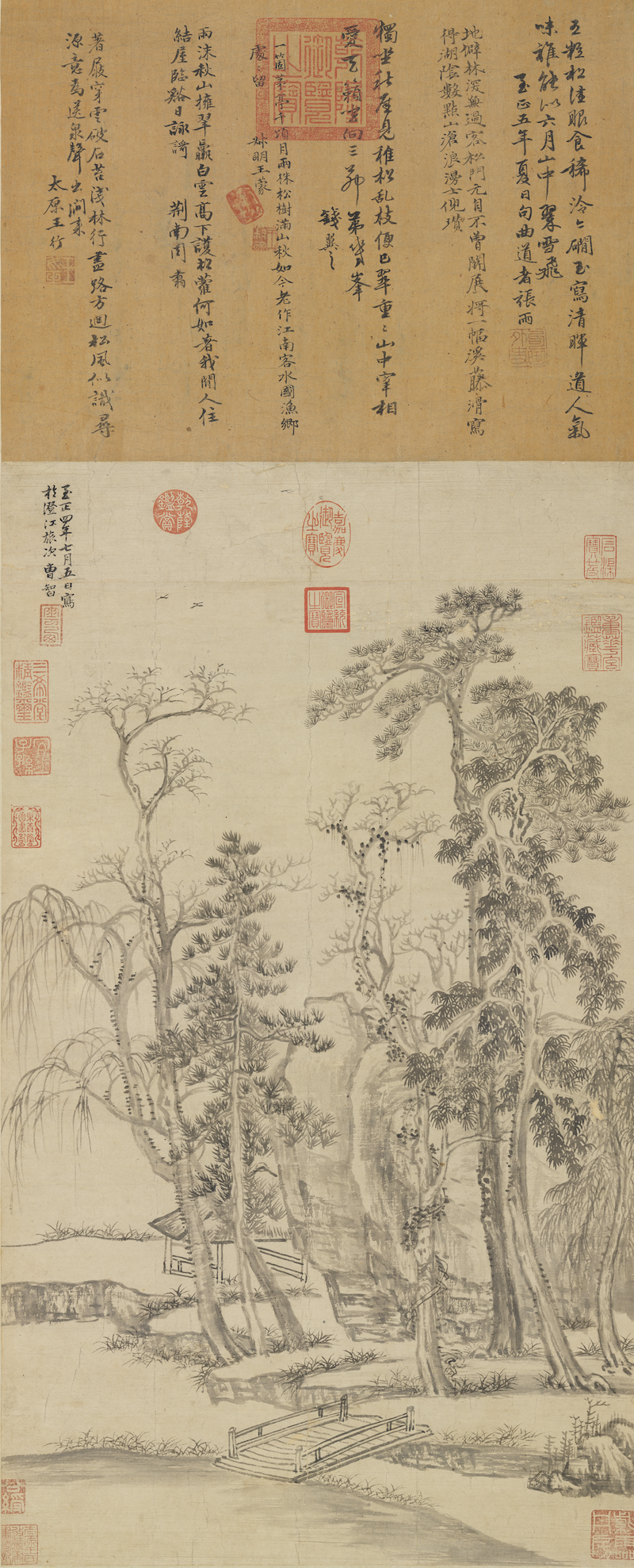
Yuan Cao Zhibai (type) "Dianlin Pavilion Picture" axis Collection of the National Palace Museum, Taipei
Wei Wei, a librarian of the Research Department of the Painting and Calligraphy Department of the Shanghai Museum, believes that Cao Zhibai is good at poetry and prose, and is good at painting. His landscape paintings, Li Cheng and Guo Xi, are fresh and elegant, far and wide, and not out of the mundane world. Since the Yuan Dynasty, they have been cherished by the world. In addition to calligraphy and painting, he is also proficient in water conservancy to benefit the local people. In his early years, Cao Zhibai once traveled to the capital, and he often made friends with princes and princes. However, he did not want to be an official, so he lived in the countryside in his later years, tending gardens, planting flowers, and attracting guests. As a result, elegant scholars and famous sages gathered in Songjiang, poetry, wine and slow songs, and sang with each other, and the name shook the left of the river. Under his fame, many paintings with the theme of narrating literati gatherings and depicting Cao Zhibai's house have been circulated, such as the axis of Cao Zhibai's "Picture of Snowy Peaks" and "Dianlin Pavilion Picture" of Cao Zhibai in the National Palace Museum in Taipei. These paintings present the stories of Cao Zhibai gathering and making friends with Huang Gongwang, Ni Zan, Zhang Yu and other literati. In historical materials, these pictures are without exception recorded by connoisseurs as Cao Zhibai's own handwriting. In this speech, he took "The Deep Window in the Museum - Discussion on the Authenticity of Several Cao Zhibai's Works" as the theme, selected several Cao Zhibai's paintings, and sorted out several fragments of his friendship with friends.
Tao Yuzhi, research librarian of the Shanghai Museum, gave a speech titled "Upward: The Reclusive Poet Wang Feng's Life in Shanghai in the Late Yuan Dynasty". Wang Feng (1319-1388), a reclusive poet in the late Yuan Dynasty, was originally from Jiangyin, Jiangsu Province. After living in Qinglong Town, Qingpu, at the end of the Yuan Dynasty, he met the famous water conservancy engineer and painter from Qinglong Town, Qingpu, who was well-known in the history of Shanghai and art. , The son of Ren Renfa (1254-1327), who presided over the construction of the Yuan Dynasty sluice site of "Zhidanyuan" in Putuo District, and Ren Xianzuo, who was also a famous pommel horse painter, became relatives and became the relatives of his children and married; Wang Feng's The daughter married Ren Xianzuo's eldest son, Wang Ye. The epitaphs of Ren Renfa and Ren Xianzuo, father and son, preserved in the Qingpu Museum today, although they have been severely eroded and damaged, are incomplete, but there is a preface to the tomb of Ren Gong, the deputy envoy of Xuanwei in eastern Zhejiang, and his son, Taizhou judge, written by Wang Feng. The anthology "Wuxi Collection", from which people can understand the history of many Ren's families, including Ren Xianzuo, who died before him.
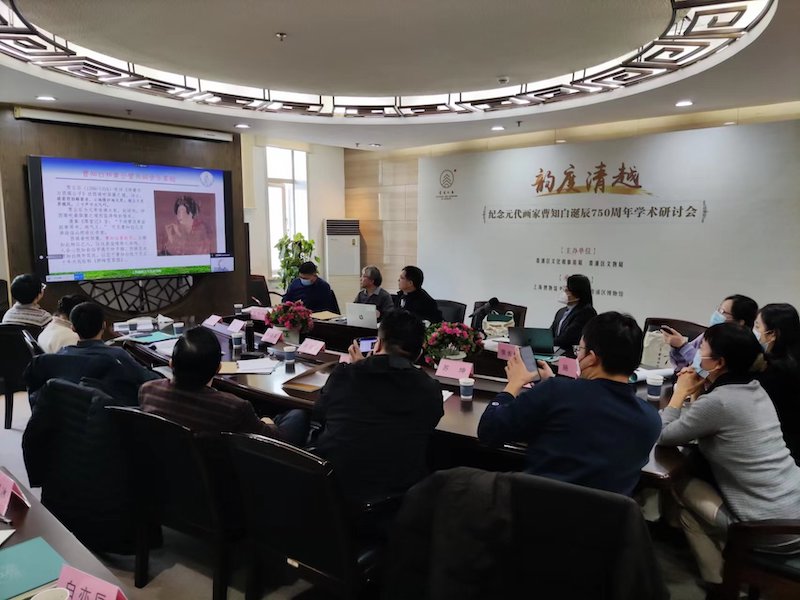
"Rhythm and Qingyue—Academic Theme Exchange Activities in Commemoration of the 750th Anniversary of Yuan Dynasty Painter Cao Zhibai's Birth"
Tao Yuzhi believes that the deeds and historical relics of Wang Feng, an aboriginal person in Shanghai, are worthy of publicity in the future display and reconstruction of Qingpu Museum, and the development of the historical and cultural exhibition of Huajing Ancient Town.
